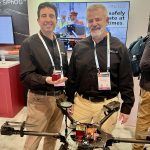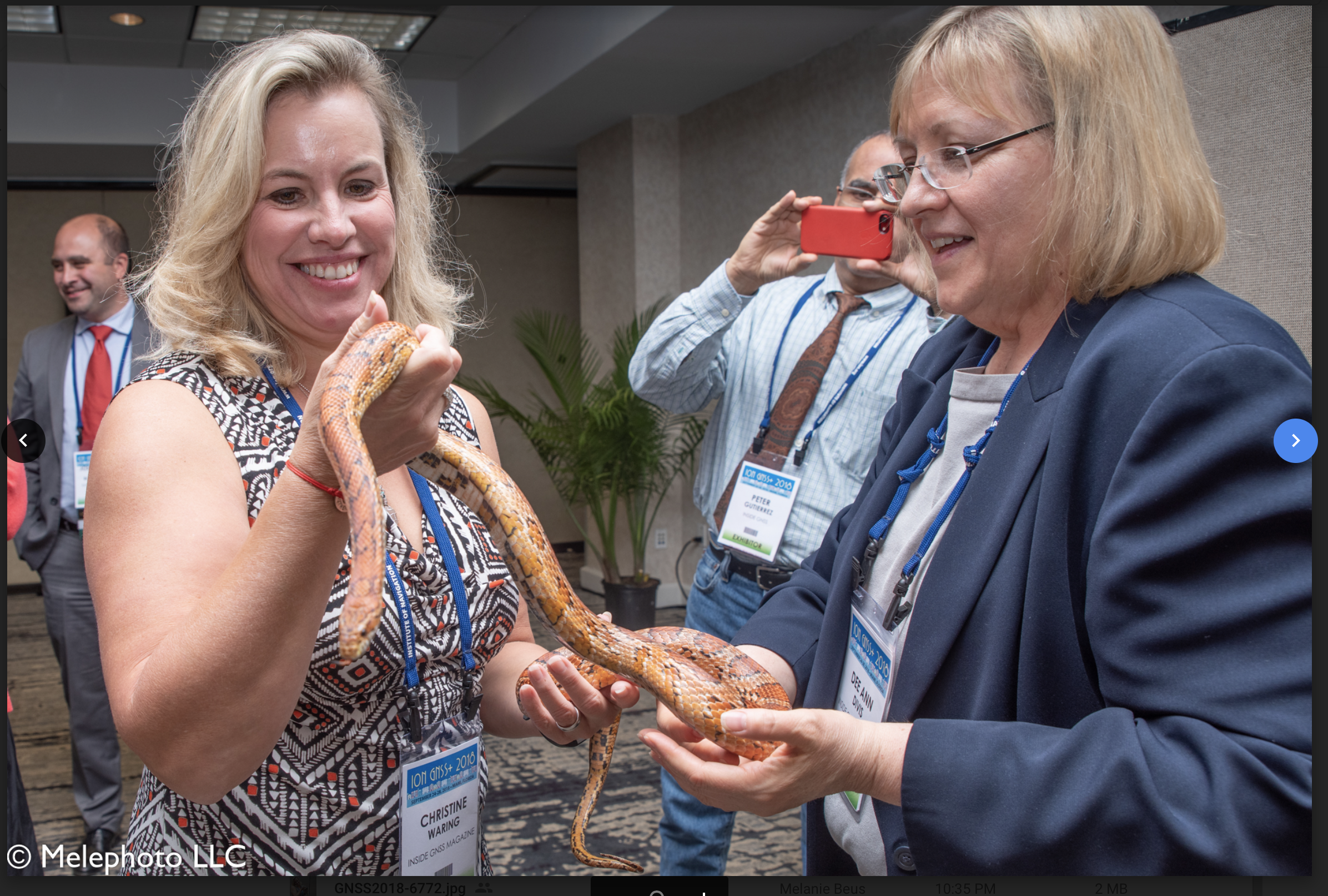ION’s JNC brings industry together to solve PNT challenges
Reliable access to PNT is critical for the warfighter, but that’s becoming more difficult as threats like jamming and spoofing continue to grow.
Manufacturers are focused on developing advanced PNT solutions that provide resilient GNSS, and many such technologies and others were on display during the Institute of Navigation’s (ION) Joint Navigation (JNC) conference in San Diego. Attendees also had the chance to sit in on sessions during the event, with enhancing Dominance and Resilience for Warfighting and Homeland Security PNT this year’s theme.
The show gives attendees and even exhibitors the chance to see and learn about the latest PNT innovations, with many of the same exhibitors returning year after year. VectorNav is among those companies, and, at this year’s event, showcased its Tactical Series of external IMUs. The solutions can connect to external IMUs, SAASM or M-Code GPS receivers to provide a more robust solution in GPS contested environments.
“This is always an important event for us,” VectorNav’s Vice President, Business Development Jakub Maslikowski said. “We reconnect and engage with other companies, and learn about the latest developments in PNT technology and explore ways our technologies can benefit each other and ultimately provide benefit to the warfighter.”
A look at the technology on display
About 60 exhibitors were on hand to talk with attendees about their various solutions during the show, from receivers to antennas to simulators to IMUs.
Hexagon | NovAtel highlighted its GPS Anti-Jam Technology (GAJT) product line, which the company is continually improving, said Peter Soar, business development manager, military & defense at NovAtel. GAJT integrates easily into new platforms and also can be retrofitted onto existing platforms, providing protection from jamming as well as situational awareness messages when a jammer is detected.
Hexagon | NovAtel also showcased its OEM7 GNSS receivers during the conference. The company recently demonstrated that its receivers can track a Spirent Communications simulated signal that’s identical to the PULSAR signal broadcast by Xona’s low Earth orbit (LEO) satellites, Soar said, a significant development for alt-PNT. The new mini antennas, blade antennas and the Robust Dual-Antenna Receiver (RoDAR) for anti-jam were among the other products of interest to JNC attendees.
Jackson Labs, a VIAVI Solutions company, highlighted various products at their booth, including the new T/Rx, a compact, ruggedized system that can sense, capture, replay, alter and train RF signals. Military applications include Signal and Electronic Intelligence collection, electronic protection/support/attack, and interference detection and analysis.
The PNT-600 Series was also on display. The compact boxes can supplement or replace GPS signals based on connectivity to a range of timing sources, including LEO, GNSS, commercial satellite, terrestrial, wireline and atomic clock services.
The company’s transcoder makes it possible to retrofit any legacy GPS equipment to a more resilient, secured PNT solution, VIAVI Solutions VP or Strategic Development Marvin Rozner said, and M-Code can be added for military applications.
“We take care of timing,” Jackson Labs’ Giovanni D’Andrea said. “We added anti-jamming and anti-spoofing. When you know something will happen, we take care of the issue. If L1 or L5 is blocked, we look at the other satellites and will move to another one.”
ANELLO Photonics highlighted its Silicon Photonics Optical Gyroscope (SiPhOG) technology, which uses an on-chip waveguide manufacturing process integrated with a patented silicon photonic integrated circuit. This enables Fiber Optic Gyro performance with a standard silicon manufacturing process, and represents the first new gyro technology in 20 years, CEO Mario Paniccia said.
The company recently released the ANELLO GNSS INS optical gyro inertial navigation system. The system features ANELLO’s optical gyro technology, which isn’t sensitive to temperature or vibration, and an AI-based sensor fusion engine. It offers high-accuracy positioning and orientation for autonomous land vehicles, agriculture and construction applications. ANELLO plans to launch a three axis version for aircraft like drones later this year.
“We’ve developed technology that allows us to operate in GPS denied environments,” Paniccia said. “Because of its size, weight, power and performance, we can apply the technology to broader applications. We’re now looking at land and air and eventually sea.”
JAVAD GNSS focused on two new products during the show: the TR-2S and the TR-3S. The commercial off the shelf (COTS) OEM GNSS boards, Tom Hunter said, have equivalent DOD classification and feature the company’s patented anti-spoofing and anti-jamming technology.
GPS Networking displayed its military qualified GPS Splitters. The Mil-Spec antenna distributes GPS/GNSS signals throughout facilities, aircraft and armored vehicles, splitting signals from a single antenna to two, four or eight receivers.
Boxes from GPS Networking are customizable and rugged, with about 200,000 units being used today—including those sold back in the 1990s. GPS Networking President Steve Waite said many JNC attendees visiting the booth have worked with the company before and are coming back for help with new projects.
GNSS/INS simulators like those from CAST Navigation make it possible to test in various environments and scenarios, including when jamming is present, allowing defense customers to model behaviors in any condition, said John Clark, CAST Navigation’s vice president of engineering. Different vehicles, antennas, gains and jamming intensities can be used for the simulations, with various environmental factors that could impact signal reception, constellation and satellite availability also coming into play.
Ideal Aerosmith talked with attendees about its motion simulation test equipment, including rate and position tables, flight motion simulators and centrifuges. The company also offers a lab where customers can perform testing, Business Development Manager Jason Eder said.
LinQuest highlighted its GPS Interference and Navigation tool, GIANT, a mission level simulation that evaluates how PNT system performance impacts a benign or electronic combat environment. It was first developed 25 years ago, AVP/GM Matt Oliver said, but is constantly updated as PNT technology continues to evolve. GIANT supports the entire life cycle of development from concept to training to operation.
Oscilloquartz by Adtran supplies optical cesium technology, what Nino De Falcis, senior director of business development, Oscilloquartz, ADVA, describes as the next generation. He highlighted the OSA 3300, a high-performance optical cesium clock, as well as an assured PNT technology that combines the cesium clock and a grand master clock that can accept multiple sources, such as LEO, and validate them in real time and move to whichever is the best.
“If there’s no timing there is no PNT,” he said. “Timing enables positioning and navigation. We happen to be the T.”
BAE Systems introduced the NavGuide GPS receiver, an assured-positioning, navigation and timing (A-PNT) device, at the show. It will serve as a field-installable replacement for the Defense Advanced GPS Receiver (DAGR), providing access to assured M-Code PNT data and addressing the need for warfighters to have access to the anti-jam and anti-spoofing capabilities that M-Code provides. The device is built for vehicular, handheld, gun-laying and sensor applications.
DAGR is currently used in many different mounted and dismounted platforms, BAE Director of Engineering for Navigation & Sensor Systems Todd Peterson said, so it was important to develop a replacement that’s easy to integrate into current DAGR mounts and accessories.
NavGuide features a three-inch full-color graphical user interface and is easy to learn how to use.
Orolia Defense & Security, a Safran Electronics & Defense company, announced that it’s re-branding under a new name, Safran Federal Systems, during the show. This comes after its 2022 acquisition by Safran, a global aerospace and defense company. All that’s changing is the name, Vice President of Sales and Marketing Tyler Hohman said. There will be no change in leadership, and customers will work with the same people they have for years.
Announcing the rebrand at JNC allowed the team to talk with many customers in person and to address any questions they had. The company also showcased its Hemispherical Resonator Gyro (HRG) Crystal technology that can be integrated with M-Code.
“You can now integrate a high-end navigation solution using HRG crystals and pair it with our M-Code PNT solutions,” he said. “There aren’t many groups in the market that can offer ultra high-end inertial paired with M-Code capability.”
NavtechGPS exhibited at JNC for the first time, promoting two upcoming courses. The first, Course 346, GPS/GNSS Operation for Engineers and Technical Professionals, can be taken as a full four-day course or a two-day course, Seminar Manager Trevor Boynton said. The shorter course provides an introduction to GPS while the four-day option gets into more technical concepts. The second course, 557, Inertial Systems, Kalman Filtering and GPS/INS Integration, is a five day course that takes a deep dive into these concepts, offering a hands-on component with different Kalman filters.
SiTime, another first-time JNC exhibitor, is replacing quartz technology with semi-conductor technology in its oscillator chips, CEO Rajesh Vashist said. The company’s Endura COTS Ruggedized MEMS Timing Solutions are engineered for harsh environments and are more rugged as well as more shock, vibration and temperature resistant.
SWaP was certainly a concern for many attendees, Mayflower Communications CEO Triveni Upadhyay said, especially those looking for anti-jam solutions for small UAS. That’s a focus for Mayflower, with its latest product offering a four channel GPS anti-jam solution with a small SWaP. Chelton, as the only UK-based company at the show, also spent a lot of time talking with attendees about anti-jam options. Chelton leverages its expertise in antennas to provide multi-channel anti-jam, Avionics Business Unit Manager David Collins said.
NextNav Director of Product Marketing Jay Patel was at the show to talk about TerraPoiNT, a 3D PNT solution that can provide resilient PNT without relying on satellite signals. Other exhibitors included Aevex Aerospace, Acutronic, Microchip Technology, the Air Force Research Laboratory, Psionic, Syntony GNSS, Spirent Federal Systems, L3Harris and Xona Space Systems.
While the show floor closed on Wednesday afternoon, sessions continued through Thursday, covering a variety of topics such as complementary PNT, IMU applications and simulation. Next year’s JNC is slated for June 3 to 5 at the Northern Kentucky Convention Center in the greater Cincinnati area.






